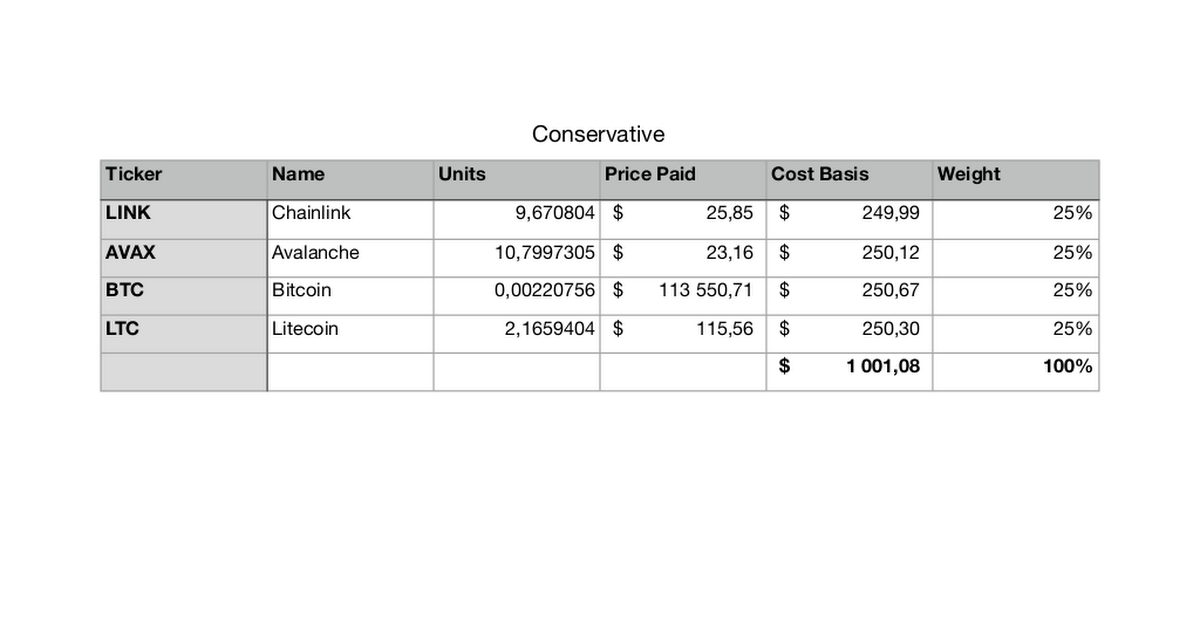Letting a team of AI agents manage my crypto portfolio

I'm the founder and creator of the AI agent platform Nelly, and while experimenting with a Crypto Analyst agent, I got curious about its real-world performance. So I decided to let a team of AI agents create and manage a crypto asset portfolio for me, actually three portfolios: one conservative, one balanced, and one aggressive. The agents will choose which crypto assets to research, analyse them one-by-one with a 6-month outlook, and then assemble portfolios that match each risk level based on those reports. I'll have the agents manage these portfolios monthly and track their performance against a few benchmarks.
Note: These aren't day-trading bots chasing patterns. They're investment agents that construct a portfolio from their own research and then monitor it periodically.
The AI agent platform
Nelly is a platform for creating AI assistants using natural language. Agents in Nelly are built by breaking a problem into specialized sub-agents, each with its own set of instructions. They run locally on your computer and can use tools such as a browser, a calculator, and a JavaScript runtime. The LLM used is Anthropic's Claude 4 Sonnet, and I used ChatGPT to help draft the specs for the agents in this article. I've published them to the Nelly Marketplace so you can see how they work, try them yourself, or even improve them and make your own versions.
Scouting for crypto assets
To analyze crypto assets, the agents first need a shortlist. For this I created the Crypto Token Scout agent, which compiles a diversified list of tokens based on constraints like "exclude stablecoins", minimum 24-hour volume, and more.

I then asked it for 20 good candidates:
Suggest 20 tokens that are good candidates to research further for inclusion into a 6-month portfolio.
And in under 10 minutes it came back with these 20 crypto tokens:
| Symbol | Name | Network | Sectors | Score |
|---|---|---|---|---|
| BTC | Bitcoin | Bitcoin Network | Store of Value | 0.846 |
| ETH | Ethereum | Ethereum Network | Smart Contract Platform | 0.812 |
| SOL | Solana | Solana Network | Smart Contract Platform | 0.792 |
| XRP | XRP | XRP Ledger | Payments | 0.776 |
| LINK | Chainlink | Ethereum Network | Oracle/Infrastructure | 0.724 |
| ADA | Cardano | Cardano Network | Smart Contract Platform | 0.720 |
| AVAX | Avalanche | Avalanche Network | Smart Contract Platform | 0.692 |
| UNI | Uniswap | Ethereum Network | DeFi/DEX | 0.676 |
| ENA | Ethena | Ethereum Network | DeFi/Yield | 0.676 |
| ARB | Arbitrum | Arbitrum Network | Layer 2/Scaling | 0.620 |
| LTC | Litecoin | Litecoin Network | Payments | 0.604 |
| AAVE | Aave | Ethereum Network | DeFi/Lending | 0.589 |
| APT | Aptos | Aptos Network | Smart Contract Platform | 0.580 |
| XLM | Stellar | Stellar Network | Payments | 0.572 |
| HYPE | Hyperliquid | Hyperliquid Network | DeFi/DEX | 0.557 |
| NEAR | NEAR Protocol | NEAR Network | Smart Contract Platform | 0.548 |
| POL | Polygon | Polygon Network | Layer 2/Scaling | 0.548 |
| DOT | Polkadot | Polkadot Network | Interoperability | 0.532 |
| SHIB | Shiba Inu | Ethereum Network | Meme/Community | 0.524 |
| MNT | Mantle | Mantle Network | Layer 2/Scaling | 0.512 |
Read the entire output with methodology here: https://timothyej.com/crypto-token-research-queue-20-selected-assets/
Reviewing the list
The list contains 20 tokens as requested and they all have a minimum 24h volume of $5M, are at least 30 days old, and listed on at least 3 exchanges. The diversity caps are also respected (max share per sector: 35%, max share per network: 40%) and the list has no stablecoins.
While the list is correct, the summary has a couple of errors:
- ⚠️ There are 6 Ethereum Network tokens, not 5.
- ⚠️ The "data fetched" timestamp should be 13 August 2025, not "2025-01-13"
Conclusion: These are minor mistakes and in this case they don't matter as the summary is not being used down stream.
Researching and analyzing the crypto assets
With a diverse list of crypto assets, I built the Crypto Analyst agent to research and analyze each token and output a comprehensive, decision-ready brief for each:

I had the agent analyze each candidate one-by-one using this prompt:
Analyze [Name]'s ([<Symbol]) performance and outlook for the next 6 months, including technical analysis and market sentiment.
On my machine it took about 15-30 minutes per asset. I saved all reports as Markdown files for the next step. Nelly agents can only run one task at a time, so I spread this over a couple of days (total: 6h 47m 21s). You can find all reports below, unedited (except for the main title):
Costs
To produce all of these reports cost me ~$130 in LLM costs.
Reviewing the reports
It would have been too much work to verify every report, so I picked 5 of them. I checked both manually and with the help of ChatGPT, and verified all of ChatGPT's claims before including them here. Treat this as a sanity check rather than a full audit.
Note: I did not fix any of the mistakes AI did as that would somewhat go against the idea of having AI manage my portfolios.
AAVE
- "$35.61B in Total Value Locked (TVL)" ⚠️ Correct according to CoinMarketCap, but conflicting with Token Terminal ($58B).
- "Active Users: +5.8% (94,500 unique addresses)" ⚠️ Seems to be +16.5% (https://tokenterminal.com/explorer/projects/aave/metrics/)
LTC
- "Lightning Network: Planned integration for microtransactions" ⚠️ Litecoin already has Lightning Network.
- "ETF Confidence: "All-time high" confidence from industry experts" ⚠️ Based on old news, Litecoin ETF decision delayed to October 2025.
- "Sharpe Ratio: 2.35 (excellent risk-adjusted returns)" ⚠️ Looks like this was calculated based on simulated historical price data.
ETH
- "significant 46.5% recovery from July's low of $2,942" ⚠️ July's low was even lower than that, near $2,400.
- "Pectra Upgrade: Scheduled for May 2025, expected to enhance scalability and efficiency" ⚠️ Stale news.
SHIB
- "Shibarium L2: Over 715M transactions processed, growing ecosystem" ⚠️ Now at over 1.5B transactions.
- "Surpassed 1M holders milestone in July 2025" ⚠️ Seems like it surpassed 1M holders much earlier than July 2025.
LINK
- "Rally Performance: +125% from $11.65 June low" ⚠️ That would a 116% increase, not 125%.
- "vs Bitcoin: LINK +43.6% vs BTC +8.2% (30-day)" ⚠️ BTC was down almost 3% (30-day).
- "vs Ethereum: LINK +43.6% vs ETH +12.8% (30-day)" ⚠️ ETH was up between 18-25% (30-day).
- "LINK Reserve Program Launch: July 2025" ⚠️ This was announced on Aug 7.
Conclusion: Based on the reports I reviewed, the outputs are accurate enough for this experiment. However, I do have some ideas on how to improve their accuracy further, but that's for the next iteration.
Allocating the portfolios
With 20 candidates and fresh 6-month analyses, I built the Crypto Portfolio Allocator agent to construct an optimal portfolio for each risk profile:

It computes a risk-adjusted score for each asset from the reports, ranks them, and proposes a diversified allocation matched to the desired risk. The first portfolio took ~36 minutes (including parsing and scoring). The other two took ~5 minutes each since the parsing and scoring were already done. Here are the results:
Conservative
| Ticker | Sector | Weight % | Amount (USD) | Notes |
|---|---|---|---|---|
| LINK | Oracle infrastructure | 25.00% | $250.00 | Top-ranked asset with strong fundamentals. Key risks: competitive pressure from Pyth/RedStone/Chronicle, centralization concerns, valuation risk after 125% rally |
| AVAX | Layer 1 blockchain | 25.00% | $250.00 | High-scoring L1 blockchain with solid fundamentals. Key risks: competitive pressure from Solana, validator concentration, regulatory uncertainty |
| BTC | L1 blockchain digital gold store of value | 25.00% | $250.00 | Digital gold standard with proven track record. Key risks: regulatory headline risk, mining pool concentration, exchange security vulnerabilities |
| LTC | Payment-focused cryptocurrency | 25.00% | $250.00 | Established payment-focused cryptocurrency. Key risks: high Bitcoin correlation (96%), mining centralization, ETF approval uncertainty |

Balanced
| Ticker | Sector | Weight % | Amount (USD) | Notes |
|---|---|---|---|---|
| LINK | Oracle infrastructure | 18.92% | $189.23 | Leading oracle network with strong fundamentals, though faces competitive pressure from emerging solutions |
| AVAX | Layer 1 blockchain | 15.77% | $157.70 | High-performance L1 with strong ecosystem, competitive positioning vs Solana |
| BTC | L1 blockchain digital gold store of value | 15.14% | $151.39 | Digital gold standard with institutional adoption, regulatory headline sensitivity |
| LTC | Payment-focused cryptocurrency | 15.14% | $151.39 | Established payment coin with ETF potential, high Bitcoin correlation (96%) |
| AAVE | DeFi | 13.04% | $130.36 | Leading DeFi lending protocol, governance and security considerations |
| APT | Layer-1 blockchain | 11.48% | $114.80 | Innovative L1 technology, token unlock schedule presents near-term pressure |
| ADA | L1 blockchain smart contract platform | 10.51% | $105.13 | Established smart contract platform, current valuation concerns (NVT 4.5x overvalued) |

Aggressive
| Ticker | Sector | Weight % | Amount (USD) | Notes |
|---|---|---|---|---|
| LINK | Oracle infrastructure | 12.58% | $125.77 | Strong oracle positioning despite competitive pressure from Pyth/RedStone; valuation risk after 125% rally |
| AVAX | Layer 1 blockchain | 10.48% | $104.81 | Solid L1 fundamentals but faces competitive pressure from Solana; validator concentration concerns |
| BTC | L1 blockchain digital gold store of value | 10.06% | $100.61 | Digital gold store of value with regulatory headline risk; mining pool concentration concerns |
| LTC | Payment-focused cryptocurrency | 10.06% | $100.61 | Payment focus with high Bitcoin correlation (96%); ETF approval uncertainty |
| AAVE | DeFi | 8.66% | $86.64 | Leading DeFi protocol with governance centralization and security concerns; high valuation multiple |
| APT | Layer-1 blockchain | 7.63% | $76.30 | Emerging L1 with token unlock risk ($54M scheduled); technical breakdown risk below $4.14 |
| ADA | L1 blockchain smart contract platform | 6.99% | $69.87 | Smart contract platform with valuation risk (NVT 4.5x overvalued); governance controversies |
| DOT | Layer-0 protocol / Interoperability / Infrastructure | 6.71% | $67.08 | Interoperability focus with regulatory uncertainty; limited DeFi ecosystem vs competitors |
| ETH | L1 blockchain DeFi infrastructure smart contract platform | 6.71% | $67.08 | DeFi infrastructure leader with MACD bearish divergence; validator concentration risks |
| MNT | Layer 2 scaling solution | 6.71% | $67.08 | L2 scaling solution with centralization concerns; smart contract vulnerabilities |
| NEAR | L1 blockchain | 6.71% | $67.08 | AI ecosystem play with extreme P/S ratio (984x); high volatility (85.6%) |
| POL | Layer-2 scaling solution DeFi infrastructure | 6.71% | $67.08 | L2 DeFi infrastructure with network outage risks; intense L2 competition |

Costs
These are the LLM costs for allocating the portfolios:
- Conservative: $6.4 (includes report parsing and asset scoring)
- Balanced: $0.6
- Aggressive: $0.6
Reviewing the allocations
All the weights and amounts sum up correctly and the agent allocated the portfolios using the best-scoring assets. I reviewed the scores for the assets in the Conservative portfolio and the only possible error I found was that it included low liquidity / thin markets (+0.4) in the Risk Index for AVAX resulting in a lower Risk Adjusted Score (0.375 instead of 0.450).
Tracking performance
I'm tracking each portfolio against four benchmarks: BTC, ETH, and two crypto indices: NCI and COIN50. NCI is Nasdaq's Crypto Index, and COIN50 is Coinbase's index consisting of the top 50 leading crypto assets. The indices allow me to track whether my portfolios are performing better, worse, or the same as the crypto market overall. And comparing against BTC and ETH will tell me whether diversifying will have a better return than just holding BTC or ETH.
I'll update the performance weekly here:

Next steps: Monitoring and Rebalancing
This isn't about day trading, so I don't want the agents making daily trades. The agent did recommend watching for stop-loss levels, major events, and other things that could justify rethinking positions. It also recommended monthly rebalancing, so I'm going to create a Rebalancing agent and perhaps a Monitoring agent to handle this.
Follow the progress
I'll keep posting updates on performance and on new agents I build for rebalancing and monitoring. Follow along here or on X to stay up to date. To the moon! 🚀
Want to comment? Leave a comment on the post on X.







